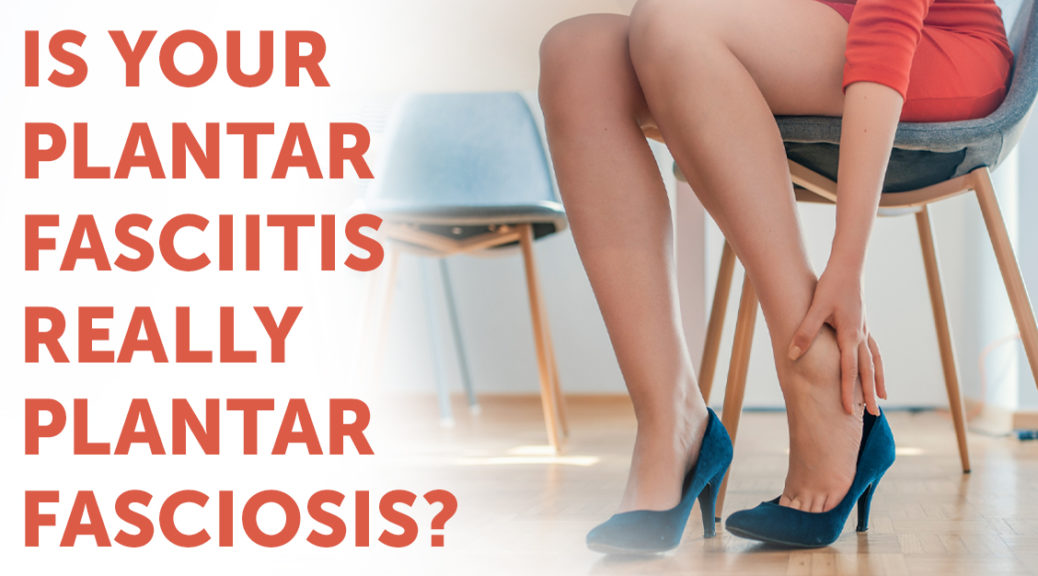
There is a pain in your feet that has been bothering you for quite a while now.
You brush it off and put on your shoes in the morning to go to work. By the end of the day your feet are throbbing, and you realize there is a problem. Your feet handle the task of getting you from one place to another every single day, and sometimes you can experience pain when the thick band of tissue on the bottom of your foot becomes inflamed. This is called Plantar Fasciitis-or is it Plantar Fasciosis?
Plantar Fasciitis
Plantar fasciitis, pronounced PLAN-tur fas-e-I-tis (in case you were wondering), is one of the most common causes of foot pain. This is when pain and inflammation of the thick band of tissue on the bottom of your foot, called the plantar fascia, that connects the heel bone to the toes and creates the arch of the foot. When the plantar fascia becomes inflamed, it is called plantar fasciitis. This may be causing that stabbing pain you’ve been feeling in the morning, or when you stand up after sitting for a long period of time. Once your foot warms up, the pain of plantar fasciitis normally decreases, it may return after long periods of standing or after getting up from a seated position. This inflammation can be caused by trauma such as a fall or jumping from a height resulting in a once-off tear in the plantar fascia, or it can be the result of repetitive strain and micro-tearing from overuse or other causes. Common treatments for this condition are cortisone injections and pain medications.
Plantar Fasciosis
Chronic inflammation of the plantar fascia can cause plantar fasciitis which will evolve into plantar fasciosis (pronounced PLAN-tur fas-e-O-sis), if not treated. While fasciitis is an inflammatory process, fasciosis is non-inflammatory. Here is what this means: After the injury to your foot, the inflammation begins and tries to repair itself, but since we all need to use our feet every day, the plantar fascia is repeatedly stretched causing more tears all the while trying to repair itself. After time goes on and the injury is left untreated, there is a point where the tissue that is attempting to repair itself begins to break down leading to deterioration and scar tissue. At this point, the inflammation is gone so treatments for plantar fasciitis no longer work for plantar fasciosis. So how do you treat this pain?
Inappropriate footwear is the No. 1 cause of plantar fasciosis. Footwear that has a narrow or tapered toe box holds your big toe in an unnatural position. This happens by pushing your big toe towards your second toe, and if the front of the shoe is lifted, which is called the “toe spring” of the shoe (common in most athletic shoes). This will then pull on the foot muscle causing restriction to the blood flow to the main artery that carries blood to the bottom of your foot causing pain, inflammation, and tissue degeneration.
Here are some prevention and support tips:
- Avoid high-heels. Wearing these fashion-approved shoes shortens the calf muscle placing even more stress on your arch and heel.
- Avoid shoes with tapered toes. Your toes lose the ability to provide support for the rest of your foot when squashed together!
- Always choose shoes with shock-absorbing soles and space inside for well-cushioned insoles. You can buy them and insert them into any pair of shoes.
- Choose shoes that keep your feet in their natural position, with neither a high toe spring nor a high heel.
Don’t walk away from the pain and have a physical therapist take a look to help you sort out what type of injury you have. Those trustworthy feet of yours deserve it!
References:
https://bimptnyc.com/plantar-fasciosis-or-plantar-fasciitis/
https://www.aaronharriscmt.com/plantar-fasciitis-vs-plantar-fasciosis/

